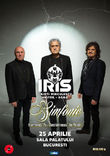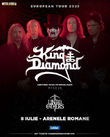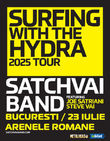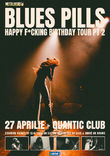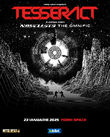
| |
METALHEAD.ro » Stiri » British Invasion
|
![]() Stiri
Concerte
Bilete
Poze
Artisti
Acorduri
Versuri
Facebook
Instagram
Stiri
Concerte
Bilete
Poze
Artisti
Acorduri
Versuri
Facebook
Instagram
British Invasion
02 Iunie 2008 Morrison
The British Invasion was an influx of rock and roll performers from Great Britain who became popular in the United States, Australia, Canada and elsewhere. The classic British Invasion was in 1964-1966, but the term may also be applied to later "waves" of UK artists to significantly impact entertainment markets outside of Britain.
The roots of the first British Invasion were sown with the explosion of American Rock and Roll in 1955. Following the successful export of Bill Haley and the Comets, Elvis Presley, and other rock 'n' roll acts in the late 1950s, large numbers of British teens formed bands to emulate their American heroes. They copied both the musical styles and the rebellious images of the Americans, both of which deeply resonated with UK youth at the time. Britain produced a few successful homegrown artists during this time, such as Cliff Richard and The Shadows. But their impact on US and world record charts was limited, with only a handful of #1 recordings (such as The Tornados (with "Telstar") and Mr. Acker Bilk with "Stranger on the Shore", both instrumentals.
The UK bands that predated the British Invasion were essentially of two distinct schools. The earliest groups were termed "skiffle" bands, and were heavily influenced by American recording artists with strong country western flavor (such as Elvis, Buddy Holly, and the Everly Brothers), and the classic guitar rock sound of Chuck Berry and others, as well as the local example of Lonnie Donegan. By the early 1960's, a second school of bands had also developed, mainly around London, comprised of groups playing rhythm and blues based on the more sound of classic American Blues artists such as Muddy Waters and Howlin' Wolf. All of these bands honed their art by extensive live performances around Britain and on the European continent (most notably in Hamburg, Germany.) By 1961-1962, a seasoned core of these bands began to develop truly original variations on the American musical styles. The meteoric breakout of the Beatles in the UK market in 1963 proved to be the catalyst for the explosion. Their unprecedented success galvanized and stimulated their peers and the UK music industry as a whole, and paved the way for the imminent eruption of UK artists into the US and world markets.
During this same period, the US had become fertile ground for new musical and cultural influences. By 1964, the youth-oriented American music market had essentially lost the power and creative drive of the original rock and roll explosion of 1955-1960. The market was now characterized by a slick, regressive, formulaic sound (with notable exceptions being the talented Motown artists and the Brill Building songwriters). Also, the assassination of President John F. Kennedy in late November 1963 had caused a deep national trauma in the US, creating a cultural vacuum that was primed to be filled by fresh outside influences. At this moment, Capitol Records released The Beatles' "I Want to Hold Your Hand" with a huge public relations campaign. "I Want to Hold Your Hand" zoomed to the top of the USA charts just as The Beatles came to America for the first time. Their historic appearance on The Ed Sullivan Show on February 9, 1964 was watched by what was then the largest television audience in history. This appearance was a remarkable social and cultural milestone of the 1960's, and marked the dramatic start of the British Invasion.
The Beatles' two year backlog of hit songs from England quickly came to dominate the American charts, and on April 4 of that year they occupied the top five spots on the Billboard magazine Hot 100 music survey, a feat unmatched before or since. Their success opened the floodgates for other British acts to market their music in the United States, beginning with The Dave Clark Five. They were quickly followed (in rough chronological order of US chart success) by Gerry and the Pacemakers, Peter and Gordon, The Animals, The Kinks, Manfred Mann, Herman's Hermits, the Rolling Stones, The Zombies, and Petula Clark by the end of 1964.
American bands were quick to pick up on the look and sound of the British groups. Groups such as the Byrds incorporated the British musical styles, and also the hairstyles and dress of the British Bands. Bob Dylan was also partially inspired in 1965 to transition from Folk Music to Rock and Roll by the British Invasion artists. The British Invasion also stimulated the widespread formation of new rock and roll bands in America, just as occurred in the UK ten years earlier under the influence of American artists.
The original British Invasion peaked in late 1965-early 1966, and had essentially played out by 1967, when the recording styles of British and US artists had essentially ceased to be distinct from one another. By this time, the styles and influences of the British bands had completely recharged the American rock and roll scene, and popular music entered a remarkably creative and influential period that lasted into the 1970s. It gave rise to numerous sub-genres, as Folk Rock, psychedelic music, Garage Bands, Acid Rock, and many others.
The influence of the original, 1960s British Invasion upon the subsequent development of rock music cannot be overstated. The British Invasion made standard the model of the self-contained rock group (as opposed to the solo rock performer backed by anonymous stage or session musicians). The movement also helped to establish the convention of rock acts composing their own tunes. The British acts, led by the Beatles, also established the standard of the high quality long-playing record album as the prime venue for the release of recordings. The sound of the British Invasion led directly to developments such as acid rock, heavy metal, and progressive rock, and would also be echoed in the punk rock, power pop and New Wave movements of the 1970s and 1980s. But just as important, the sheer sense of excitement generated by the original British Invasion helped spark a true revival and revolution in popular music and youth culture that has not been repeated.
A handful of the original invasion bands survived to end of the 1960's still popular and relevant - these were the The Rolling Stones, The Who, The Kinks and The Beatles (who disbanded just at the end of 1969). In retrospect, the music of these four British Invasion bands is seen to be the most timeless, with the most long-reaching influence and relevance to music. By contrast, the recordings of most of the rest (bands such as the Dave Clark Five and Herman's Hermits) are viewed more today as dated period pieces. But several of the influential shorter-lived Rhythm and Blues bands, such as the Animals and the Yardbirds, were instrumental in the development of the late 1960's - early 1970's hard rock scene, epitomized by such immensely popular UK bands as Led Zeppelin and Cream.
Bilete Concert 50 Cent in Bucuresti la Romaero
Toate articolele de pe site reprezinta parerea celor care le-au scris si nu punctul de vedere oficial al METALHEAD
Bilete Concert Coldplay pe Arena Nationala din Bucuresti © copyright 2004 - 2023 METALHEAD.ro
